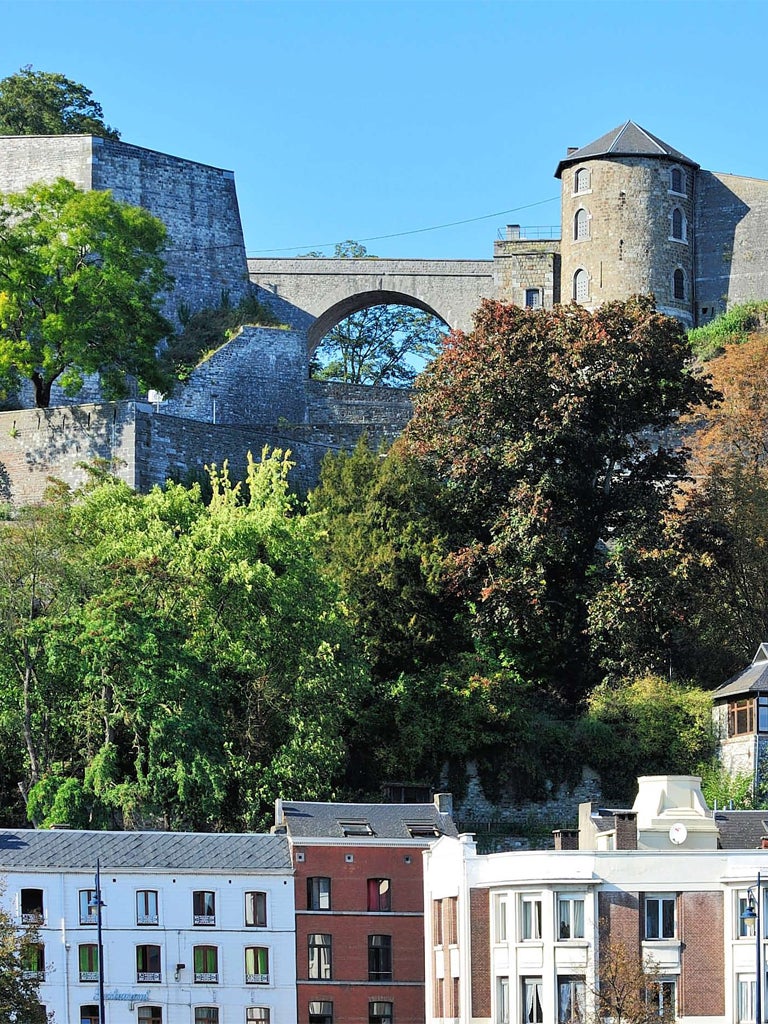Namur: Adventures in Europe's historic heart
Henry Palmer on a stylish city that bears the scars of war with dignity

Handsome, thriving Namur is home to the parliament of Wallonia, and also the setting for a large university. Alongside this is a host of heritage attractions that reflect the fascinating history of intensive European power play here. For the city is more or less at the mid-point of a triangle between France, Germany and the Netherlands. Belgium is famously at the crossroads of Western Europe – and Namur, strikingly set on the confluence of the Meuse and Sambre rivers, lies at the very heart of this intersection. It was, of course, an enormously important objective during the First World War.
Advancing west along the Meuse, about 300,000 German troops marched on the area in mid-August 1914, and thundering along with them were horses, traction engines and guns capable of projecting large and devastating shells. The first bomb of the attack fell on the city's railway station on 17 August. By 21 August the invaders had established a siege, and were raining fire on the city's outlying defences. As with Liège, these took the form of a ring of forts, in this case nine (Maizeret, Andoy and Dave on the right bank of the Meuse; Malonne, Saint-Héribert, Suarlée, Emines, Cognelée and Marchovelette on the left), and as with Liège they were unable to withstand Germany's formidable "Big Bertha" howitzers. On 23 August the nearby town of Dinant suffered the first in a long series of attacks – as had Visé, near Liège, nearly three weeks earlier. By 24 August the Belgian troops were forced to abandon their defensive forts, and Namur fell to the Germans.
When you arrive in Namur today you see a city dominated by its ancient citadel ( citadelle.namur.be), a stupendous arrangement of fortifications spread over a dramatically rocky hill that rises steeply beside the Meuse-Sambre confluence. Yet these played little part in the First World War. By 1914 the citadel had become obsolete as a defensive fortress because of the development of long-range guns: it lies close to the town and had it remained in full military use it would have posed great danger to the civilians living just below. Hence the separate ring of forts that were constructed about 7km away. However, these are not open to visitors today, so to learn more about Namur during the First World War you should head to the citadel: its formers barracks now house an exhibition centre, with one of the rooms devoted to a pithy display on the fighting.
Diagrams and explanations present absorbing detail about the outlying forts and the great military engineer Henri Brialmont who devised and constructed them. Massive triangular structures were sunk into the ground – they were made of concrete and considered revolutionary when built in the late-1880s. Yet it is astonishing to find out how rudimentary communications between them still were in 1914. There was no radio or telephone contact between the forts. The citadel remained the nerve centre for messages, which were conveyed by carrier pigeon. Meanwhile the Germans arrived with falcons to hunt the pigeons down.
Within the citadel, the military dovecote lay on slopes just below the barracks. In the typically enterprising style of Namur's residents today, it is now a perfumerie ( delforge.com) which is increasingly renowned for its atmospheric displays of scent-making. There is a great deal to see in this vast historic site. Guided tours are conducted around underground passages created at the turn of the 17th century by Louis XIV when he too laid siege to Namur. Walks are also conducted around the remains of the citadel's medieval sector. Meanwhile, a cheerful tourist shuttle takes visitors around the peak of the complex where, in the 1890s, King Leopold II transformed much of the citadel into a pleasure park, planting trees, creating an outdoor theatre and masterminding the construction of a stadium for concerts and other entertainments.
Alternatively, you can simply walk (at no charge) around the old fortifications: there are five well-signed routes of varying length, which are dotted with information boards. The views from the historic battlements are terrific, especially those to the north across the water and over the roofs and spires of Namur's old town. From the information and exhibition centre in the old barracks, it's just a 15-minute walk to the cafés of Namur's historic heart – you'll find a lively choice around picturesque Marché aux Légumes.
Staying there
Les Tanneurs (00 32 8124 0024; tanneurs.com) at 13B Rue des Tanneries is an intriguing small hotel created from 11 ancient houses in the old tanning district. It offers 32 rooms that have been carefully fashioned to fit the buildings, some split-level with spiral staircases, some with amazing vaulted ceilings and skylights. The hotel is also home to two of Namur's most lauded restaurants: L'Espièglerie for fine dining and Le Grill for brasserie fare. Doubles cost from €55 room only.
Eating there
There is a wide variety of excellent restaurant options here, but for the very best, head for Cuisinémoi (00 32 8122 9181; cuisinemoi.be) – a real gourmet haven lying just behind the Walloon parliament building at the foot of the citadel on Rue Notre Dame. It's a chic little establishment which has boasted a Michelin star since 2010 and offers a delicately balanced set menu every night based on the very best seasonal produce.
Subscribe to Independent Premium to bookmark this article
Want to bookmark your favourite articles and stories to read or reference later? Start your Independent Premium subscription today.

Join our commenting forum
Join thought-provoking conversations, follow other Independent readers and see their replies